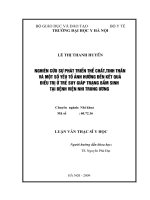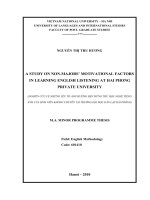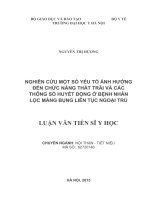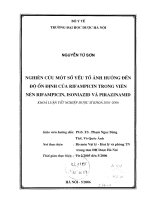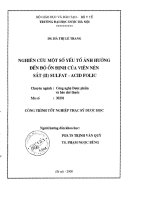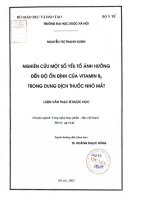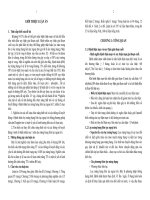A STUDY ON FACTORS THAT AFFECT ON THE FIXED BED GASIFICATION PROCESS NGHIÊN cứu một số yếu tố ẢNH HƯỞNG đến QUÁ TRÌNH KHÍ hóa TRẤU TẦNG cố ĐỊNH
Bạn đang xem bản rút gọn của tài liệu. Xem và tải ngay bản đầy đủ của tài liệu tại đây (421.2 KB, 6 trang )
Kỷ yếu hội nghị khoa học và công nghệ toàn quốc về cơ khí - Lần thứ IV
A STUDY ON FACTORS THAT AFFECT ON THE FIXED BED
GASIFICATION PROCESS
NGHIÊN CỨU MỘT SỐ YẾU TỐ ẢNH HƯỞNG ĐẾN QUÁ TRÌNH KHÍ HÓA TRẤU
TẦNG CỐ ĐỊNH
Hoang An Quoc1a, Nguyen Vu Lan1b, Nguyen Thanh Quang2, Nguyen Ngoc Tuyen3c
1
HCMC University of Technology and Education, HCMC, Vietnam
2
HCMC University of Technology, HCMC, Vietnam
3
Industrial University of HCMC, HCMC, Vietnam
a
b
; ;
ABSTRACT
The rice husk gasification technology in Vietnam has been focusing on applications
inlife and industrial production.This article presents an experimental investigation on impacts
of two key system variables, air speed in the incinerator and humidity of rice husk fuel, on the
system efficiency. Results have shown that higher humidity of input husk fuel will lead to
lower system productivity or may even stop the burning process. Meanwhile, only at a
specific suitable and limited inlet air velocity range can the overall gasification efficiency
reach to its maximum value.
Keywords: fixed bed gasification; biomass gasification; gasification technology; rice
husk gasification.
TÓM TẮT
Công nghệ khí hóa trấu ở nước ta hiện nay đang được quan tâm và đưa vào ứng dụng
trong đời sống và sản xuất. Bài báo này giới thiệu nghiên cứu thực nghiệm về ảnh hưởng của
hai tham số chủ yếu của hệ thống, tốc độ khí trong lò đốt và độ ẩm của nhiên liệu trấu, tới
hiệu suất của hệ thống khí hóa trấu tầng cố định. Kết quả chỉ ra rằng độ ẩm của trấu đầu vào
càng cao thì hiệu suất sinh khí càng thấp thậm chí sẽ dẫn đến việc ngừng quá trình cháy của
hệ thống.Trong khi đó, chỉ ở một khoảng giá trị vận tốc khí đầu vào nhất định thích hợp thì hệ
thống mới có thể đạt hiệu suất cao nhất.
Từ khóa: khí hóa tầng cố định; khí hóa biomass; công nghệ khí hóa; khí hóa trấu.
1. INTRODUCTION
In the current situation of energy shortage, running out fossil fuels and increasingly
serious environmental pollution caused by fuel waste emissions, solutions utilizing renewable
energy resources are of special interest [1,2].Vietnam is the leading rice-producing country in
the world and thus the amount of rice husk coming from the rice-processing factory is
extremely large. Therefore, the husk gasification technology has been focused ondevelopment
in the recent years in order to make use of this huge energy source. Besides, with great
advantages of simplicity in manufacturing and relatively low cost, the fixed bed gasification
technology is being applied primarily nationwide.
The fixed bed gasification method with the advantage of being easy for fabrication, low
initial investment cost is being mainly applied in the country at present [3~6]. However, the
capacity of this system is not yet high leading to a limited efficiency. To improve the
productivity of the gasification system, the determination of the influence of the inputs
onperformance of the system is extremely important. This paper introduces a study of the
513
Kỷ yếu hội nghị khoa học và công nghệ toàn quốc về cơ khí - Lần thứ IV
influence of gas velocity in the burner and the rice husk moisture to the performance of fixed
bed rice husk gasification system.
2. FUNDAMENTAL THEORY
2.1. Gasification process
Gasification processis an incomplete burning of solid fuels. In general, biomass fuels
areburned completely to produce heat and some normal products including N2, water steam,
CO2 and redundant O2. However, in gasification process, it is thesolid fuels to be redundantly
supplied. In other words, the combustion is always lack of O2. As a result, the obtained
gaseous product is a mixture of CO, H2, CH4 which are flammable gases and several useful
components such as tar and dirt.
2.2. Main reaction equations in gasification
In most of the cases, the following chemical reactions may take place in the gasification
process:
C + O2
CO2
(1)
2H2 + O2
2H2O
(2)
C + 1/2O2
CO
(3)
C + 2H2
CH4
(4)
CO + 3H2
CH4 + H2O
(5)
CO2 + H2
CO + H2O
(6)
C + CO2
2CO –164,9
(7)
C + H2O
CO + H2
(8)
3. EXPERIMENT MODEL AND METHODOLOGY
3.1. Experiment Equipment
Figure 1. Principle diagram
514
Kỷ yếu hội nghị khoa học và công nghệ toàn quốc về cơ khí - Lần thứ IV
The experimental model was designed and manufactured according to the principle
diagram shown in Figure1. Rice husk was continuously supplied from the feeder through a
screw into the combustion chamber. To ensures table temperature and avoid heat loss,
combustion chamber was covered thoroughly by glass fiberlayers. After gasification process
had taken in the burner, the gas was filtered through acyclone and then blown into cooler
sandtar filters. Finally, the gas was dehumidified before moving to the burner’s nozzle.
3.2. Input data and analysis
The following parameters were used to analyze the performance of the gasification
system:
- Air velocityin combustion chamber Va[cm/s]: Because of the lack of special
equipment, this parameteris calculated in directly via the airflow at the output of the blower.
- Huskhumidity Hu [%]: Humidity has a great influence on combustion process, so in
the gasification system, the moisture of the fuel is a vital parameter. Relative humidity of the
material is as the ratio between the amount of moisture contained in the material and the
volume of material.
- Heat total value Qh [Kcal]: Heat total of husk is calculated basing on the weight of
consumed husk mh [kg] and the heat value per each mass unit of the husk qh[Kcal/kg] as
shown in Eq.(9).
Qh = mh.qh
(9)
- Useful heat Qu [Kcal]: is the heat received when burning the gaseous product. Using
this value and the Heat total value, one may infer the efficiency of the gasification process by
Eq.(10).
(%) = Qu/Qh×100%
(10)
4. RESULTS AND DISCUSSION
4.1 Effect of air velocity in the combustion chamber
In order to figure out the relationships between Va and the overal system performance,
related experiments were done to show the variation trend of the system performance due to
increment and decrement of the gas velocity in the combustion chamber. Rice husk was taken
from the milling plant and left untreated; fan speed to blow air into the combustion chamber
was adjusted in the range of 1÷10cm/s and initial volume of heated water was 5kg each time.
The experiments were conducted with 7 different values of Va to collect data. The collected
results are shown in Table 1 and Figure 1. It is important to notice that due to lacking of
highly precise measuring equipment to be located at different measuring positions inside the
chamber, the obtained measurement values of this experiment are not enough to show specific
performance figures corresponding to different values of velocity. Interestingly, it has been
found that the system performance was at its maximum when the velocity varied from
2.5÷5cm/s (maximum at 4.05cm/s) and decreased when Va was out of this range. The reason
could be when air velocity was too low or too high, there was insufficient interacting time
between the solid fuel pieces and the air. Therefore, the gasification process reached to its best
efficiency only within this most suitable limited air velocity range.
Table 1.Influence of air velocity in combustion chamber
Experiment
Air velocity Va
[cm/s]
Husk heat level
Qh [Kcal]
Useful heat Qu
[Kcal]
Capacity [%]
1
1.05
3,397.68
0.00
0,00
2
2.55
3,397.68
441.70
13.00
515
Kỷ yếu hội nghị khoa học và công nghệ toàn quốc về cơ khí - Lần thứ IV
3
4.05
3,397.68
509.65
15.00
4
5.57
3,397.68
421.31
12.40
5
7.03
3,397.68
356.76
10.50
6
8.52
3,397.68
312.59
9.20
7
10.06
3,397.68
299.00
8.80
4.2. Effect of humidity husk
The dependence of the process efficiency on humidity of input fuel was tested by some
other experiments in which air velocity was fixed at the above-mentioned best value, initial
volume of heated water was 5kg each time and 5 husk samples with humidity value from 10 –
40 % were investigated. The results are shown in Table 2 and Figure 2. As explained above,
these results revealed the variation trend of this relationship. The higher the humidity was, the
more difficult for ignition process and gasification, thus, the lower the system efficiency. If
the humidity was too high, the equipment was unable to operate and the gasification could not
take place. Obviously, it was the large amount of water stored inside the input fuel prevented
the flame of gasification. Although the lower humidity the better performance, the lower
humidity requires more initial treatment which in turn need extra energy consumption. That
means this humidity preparation will pull down the overall efficiency. Besides, the humidity
value depends very much on geographic location and climate condition of the application cite.
Accordingly, a further research on an opitimized working condition should be done to
ameliorate the current gasification process.
Experiment
Table 2. Influence of humidity in combustion chamber
Humidity Hu
Husk heat level Qh
Useful heat Qu
[%]
[Kcal]
[Kcal]
Capacity
[%]
1
10.50
3,397.68
485.87
14.30
2
17.30
3,397.68
428.11
12.60
3
25.10
3,397.68
295.60
8.70
4
31.60
3,397.68
81.54
2.40
5
40.50
3,397.68
0.00
0.00
Velocity - Efficiency Chart
16.00
14.00
Efficiency %
12.00
10.00
8.00
6.00
4.00
2.00
0.00
1.05
2.55
4.05
5.57
7.03
8.52
Velocity cm/s
Figure 2. Velocity - Efficiency Chart
516
10.06
Kỷ yếu hội nghị khoa học và công nghệ toàn quốc về cơ khí - Lần thứ IV
Humidity - Efficiency Chart
16.00
Efficiency %
14.00
12.00
10.00
8.00
6.00
4.00
2.00
0.00
10.50
17.30
25.10
31.60
40.50
Humidity %
Figure 3. Humidity - Efficiency Dependence
Experiment model
Husk in feeder
Gasification flame
Burning
Temperature gauge
Gasification flame
Figure 4. Pictures of gasification model
5. CONCLUSION
Fromthe experimental results, it has been proved that both inlet airspeed of the gasifier
chamber and input fuel moisture strongly affect on the overall performance of the fixed bed
gasification system. Although this research has shown the clear relationship between each of
these two parameters with the total efficiency, further research should be implemented in
order to find out solutions to improve the performance of the system. Moreover, to accurately
investigate the system performance, it requires special equipment for analysis of gas
composition and tar after burning completed.
517
Kỷ yếu hội nghị khoa học và công nghệ toàn quốc về cơ khí - Lần thứ IV
REFERENCES
[1] Bernstein, W., Hiller, A., Schneider, M., Klemm, M., Quang, N.T., Vergasung von
Biomasse, Verfahren – Transparenz – Modellierung, 20. Deutscher Flammentag Essen
2001, VDI-Berichte 1629, S.521-526.
[2] Anil K. Rajvanshi, Biomass Gasification,
Institute,Phaltan-415523, Maharashtra, India.
Nimbkar
Agricultural
Research
[3] Thành B.T., Tuyên N.V., Hoài L.Đ.N., Nghiên cứu tính toán thiết kế buồng đốt trấu hoá
khí quy mô nhỏ sử dụng cho hộ gia đình nông thôn, Tạp chí Cơ khí Việt Nam, số tháng
7/2012.
[4] Thành B.T., Thiết kế ghi phân phối tác nhân khí cho máy sấy muối tinh tầng sôi liên tục,
Tạp chí năng lượng nhiệt Việt Nam, số tháng 5/2010.
[5] Quang N.T., Hùng Đ.T., Nghiên cứu chế tạo hệ thống hóa khí than tầng cố định ngược
chiều, Tạp chí KH & CN Nhiệt, số 77, tháng 09/2007.
[6] Quang N.T., Quốc H.A., Thông N. T., Nghiên cứu khí hóa trấu lớp cố định nhằm sản
xuất điện năng, Tạp chí KH & CN Nhiệt, số 102, tháng 11/2011.
AUTHOR’S INFORMATION
Author 1: Hoang An Quoc, HCMC University of Technology and Education, HCMC,
Vietnam, Email: , Phone: 0908197416
Author 2: Nguyen Vu Lan, HCMC University of Technology and Education, HCMC,
Vietnam, Email: ,Phone: 0913522142
Author 3: Nguyen Thanh Quang, HCMC University of Technology, HCMC, Vietnam,
Author 4: Nguyen Ngoc Tuyen, Industrial University of HCMC, HCMC, Vietnam, Email:
518


